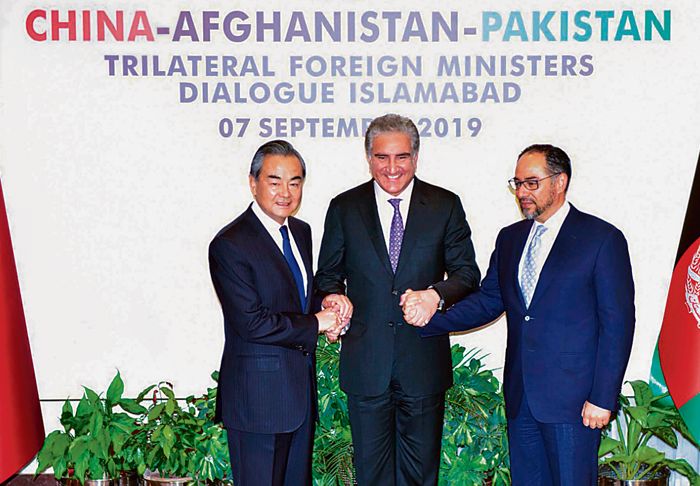
Ambitious: It is claimed that the China-Pakistan Economic Corridor (CPEC) would have a positive impact on Iran, Afghanistan, India and the Central Asian Republics.
Luv Puri
Luv Puri
Journalist and author
With its progressively increasing global stature, China’s two recent foreign policy initiatives in the region highlight distinct convergences in terms of granularities that have implications for the future of multilateralism in the region and how regional realities will play out in its realm.
On August 16, 2019, China acted on the request of Pakistan and called for a Security Council briefing on J&K under the format — any other business (AOB) — which comes under informal consultations of the council. On January 15, on the request of China, another Security Council briefing took place on J&K and this coincided with the visit of Pakistan’s Foreign Minister Shah Mahmood Qureshi to the UNHQ. China defended its moves and its spokesperson Geng Shuang said, “Because we want to work for de-escalation and work for regional peace and stability, this is out of goodwill. However, if the Indian side interprets it in other way, that will be a wrong interpretation.”
In the context of the Sino-Pakistan engagement, China’s multilateral support is in tandem with its economic investments, which are facing criticism. In an unusual blistering critique of the Sino-Pakistan relationship on November 21 last year, senior US diplomat Alice Wells, acting Assistant Secretary of State, warned Pakistan that China’s diverse range of investments in that country lacked transparency and would foster corruption and a heavier debt burden. The US diplomat was categorical in saying that the $62-billion projects, known as the China-Pakistan Economic Corridor (CPEC), lacked transparency, had incurred unjustifiable cost escalations, and had ‘debt-trap’ implications for Pakistan.
The CPEC is a part of China’s Belt and Road Initiative (BRI), with the two phases under discussion related to key infrastructure and development plans. The claim is that CPEC would benefit not only China and Pakistan but also have a positive impact on Iran, Afghanistan, India, Central Asian Republics, and the region. The project spans all four provinces of Pakistan. Apart from that, Gilgit-Baltistan and Pakistan-administered Jammu and Kashmir are also part of the same, which was the prime objection for India not joining it.
Geng Shuang rebutted and said the total debt for the CPEC was $4.9 billion less than one-tenth of the total Pakistani debt, most of which was from multi-national banks. Other Chinese officials dismissed the US diplomat’s critique of the Chinese investments as “propaganda and incitement.” Pakistani politicians and bureaucracy were also quick to dismiss the remarks.
While Gwadar in Pakistan enables China to access the Arabian Sea, financing dozens of projects in Myanmar, including a railway project, the Chinese-built Kyaukpyu deep-sea port, will provide China’s south-western provinces access to the Indian Ocean. In this context, President Xi Jinping visited Myanmar on January 17-18. This is the first time a Chinese Head of State has visited Myanmar in nearly two decades. Xi Jinping pledged to give over $580 million in aid over the next three years to support the development of Myanmar. The visit also became important as Myanmar is an important constituent of the BRI strategy. However, this economic relationship has not followed a linear trajectory as a number of Chinese projects are stalled or revised. The proposed Myitsone dam in the Kachin area in the north was called off by President Thein Sein in August 2011 following concerns over massive dislocation of human settlements and potential ecological costs.
Not too different from Pakistan, civilian institutions are weak in Myanmar. The military or Tatmadaw is the architect of the country’s present Constitution in design and substance. By the writ of the Constitution, three important ministries relating to national security, namely, defence, home and border, are held by the military. The military nominates 30 per cent of the members of parliament. No amendments can be passed without 75 per cent approval in Myanmar’s parliament. There are other startling similarities. The current Myanmar army chief Min Aung Hlaing was supposed to retire in 2016 but got an extension for another five years. In Pakistan, too, a parliamentary process is on to extend the tenure of the present chief General Qamar Javed Bajwa for another three years.
In the Asian context, the Sino-Pakistan relationship has startling similarities with Sino-Myanmar engagement. The two are China’s principal allies in South Asia and South-East Asia. In rhetorical terms, Sino-Pakistan friendship is officially depicted as higher than the Himalayas, deeper than the ocean, sweeter than honey, and stronger than steel. The same way, Sino-Myanmar is officially described in Burmese as Pauk-Phaw, meaning blood brothers.
Even in the case of Myanmar, Chinese economic investment moves in tandem with multilateral support. In the last two years, China, with its P-5 status, has often rescued Myanmar at the Security Council by opposing any bid to have a binding resolution against the alleged military action that led to the displacement of over 7,00,000 Rohingya to Bangladesh in August 2017. In fact, China has exercised shuttle diplomacy between Bangladesh and Myanmar to bridge differences between the two countries, though the tangible results have been negligible.
The impact of China’s foreign policy initiatives, including its multilateral diplomacy, is only going to increase. This is because apart from the power of veto enjoyed by China in the United Nations Security Council, China is now the second largest contributor to the peacekeeping budget. The same trend is visible in the regular budget of the UN, which funds 24 special political missions across the world and the staffing costs in its headquarters in New York and the regional headquarters in Europe, Asia, Africa and Latin America. China’s contribution will be 12.01 per cent in the next three years, up from 7.92 per cent for the 2016-18 period.
Join Whatsapp Channel of The Tribune for latest updates.




























